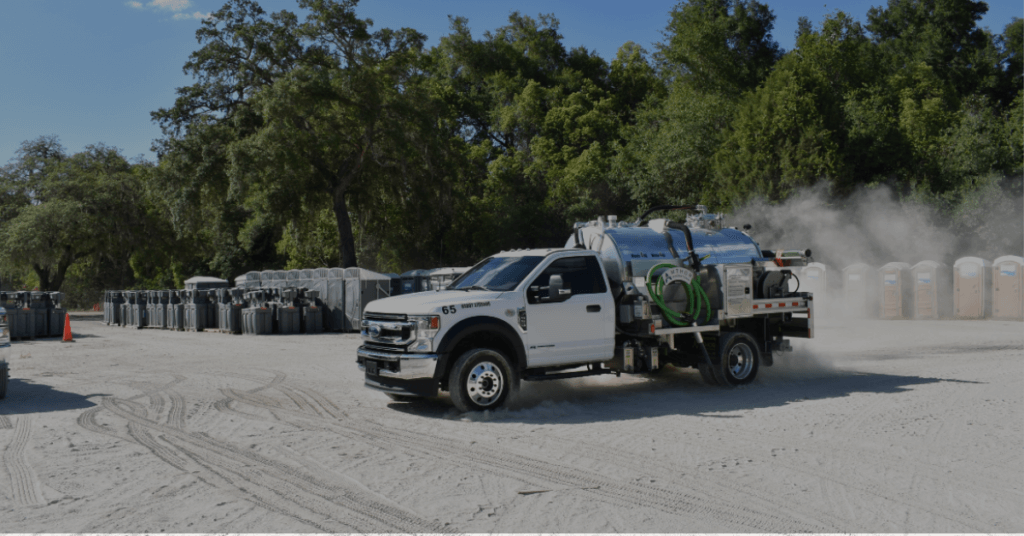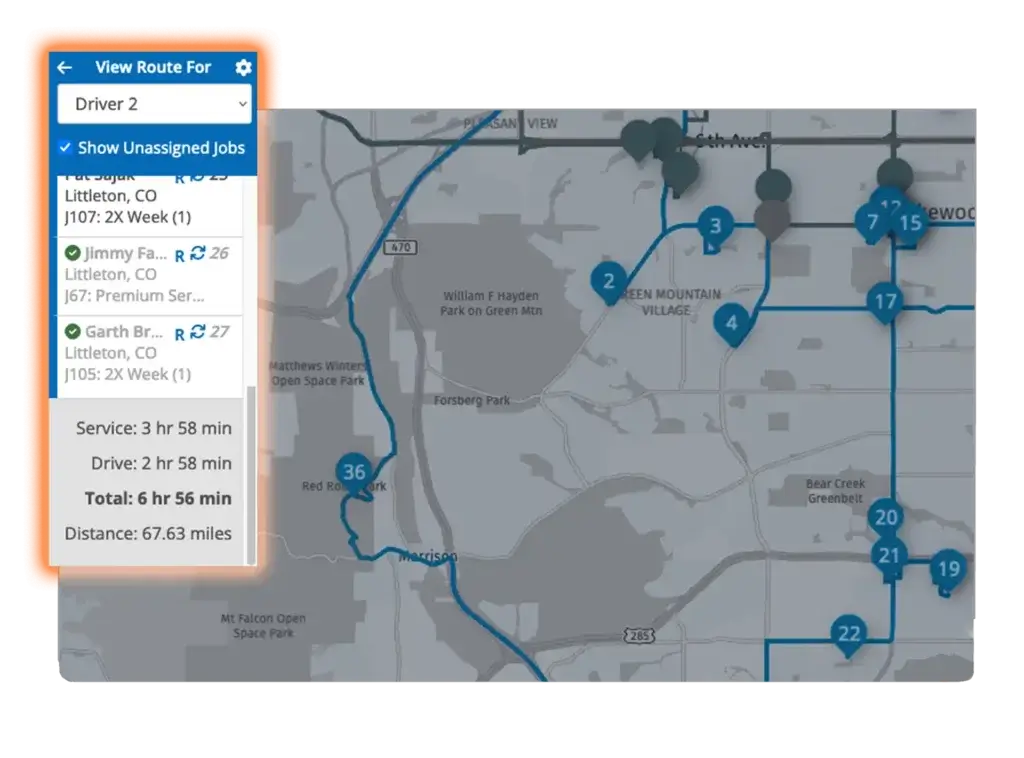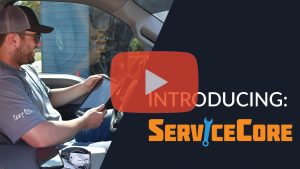The Complete Routing Playbook for Portable Restroom Operators
Welcome to “The Complete Routing Playbook for Portable Restroom Operators”—your comprehensive guide to achieving operational efficiency in your portable sanitation business.
In this playbook, we’re going to simplify the complexity of day-to-day operations and provide you with actionable strategies that you can start applying right away. Here’s a sneak peek into what’s coming up:
- We’ll begin by teaching you how to establish your service areas. Think of your service area as the heart of your business – it’s where you operate and provide your valuable services. We’ll guide you on how to smartly define this area for maximum efficiency.
- Next, we’ll dive into structuring your day. Time management isn’t just about keeping busy; it’s about prioritizing tasks to ensure that your efforts yield the most productive results.
- From there, we’ll explore route optimization. In the portable restroom rental business, your route is your lifeline. We’re here to help you make it as efficient as possible to save both time and money.
- We’ll also discuss the importance of cross-department communication. Like a tightly knit family, a well-connected business operates seamlessly, leading to a stronger overall performance.
- Lastly, we’ll cover measuring route and driver performance. As the saying goes, “What gets measured gets improved.” We’ll show you how to track your operations for continuous growth and improvement.
This playbook is designed to empower you to take your portable restroom rental business to new heights. Let’s get started!
How To Establish Your Service Areas

Establishing your service areas is a crucial step in the growth and operation of any portable restroom rental business. Correctly defined service areas can lead to improved efficiency, cost savings, and enhanced customer satisfaction.
As an owner, GM, ops manager, or dispatcher, your decision-making is vital to the success of your business. In this section, we’ll guide you through the process of outlining your service areas in a clear, concise, and actionable way.
Remember, defining your service areas is more than just putting pins on a map. It’s about understanding your resources, knowing your customers, and using this knowledge to make strategic decisions. Ready to dive in? Let’s get started.
Understanding Your Business Needs
Before you can establish your service areas, you need a clear picture of what your business can handle. Let’s break this down:
- Business Size Evaluation: Take a good look at what you’ve got. Count your fleet and staff. Understand your capabilities. This will give you a clear idea of how much work you can take on and how far you can stretch.
- Know Your Customers: Identify who your customers are and what they need. Where are they located? What kind of services do they usually require? A clear picture of your customer base will help shape your service areas.
- Think About Expansion: Are you ready to grow? If you’re consistently meeting demand and have resources to spare, it might be time to consider expanding your service areas. Keep a close eye on where demand is coming from – these could be your next target areas.
Remember, understanding your business is the first step in defining your service areas. Keep these points in mind as you move forward.
Setting Service Area Boundaries
- Map It Out: Use a physical or digital map to visualize your immediate service area. This will give you a clear picture of where your current customers are and help identify potential underserved areas.
- Understand Your Customers: Know who your customers are in this area. Are they primarily event organizers, construction companies, or residential customers? Understanding their needs can help tailor your services better.
- Local Road Knowledge: Familiarize yourself with the local road network, traffic patterns, and any restrictions or conditions that could affect your travel time. Knowing the quickest routes or shortcuts can save valuable time.
- Community Engagement: Get involved with your local community. This could mean sponsoring local events or joining the local business association. The more connected you are, the more likely you are to be top of mind when someone needs a portable restroom rental.
- Competitor Analysis: Be aware of your competition. Who else is serving your area, and what are they offering? Understanding your competition can help you find ways to differentiate your services.
By understanding your home base inside out, you can optimize your operations to serve this area most efficiently, setting a solid foundation for your portable restroom rental business.
Dealing With Out of Area Requests
So, what do you do when a request comes from an area that’s not on your list? It’s not always a straight “no.” Sometimes it can be worth it, especially if it’s a large job or a customer who needs frequent service. You’ll need a strategy to handle these “out of area” requests. We’ll go through when it makes sense to stretch your boundaries a bit and when it might be better to pass.
- Assess the Profitability: Take into account the potential revenue of the job compared to the additional cost it will incur. If the profit margin justifies the extended travel, it might be worth accepting.
- Bundle Jobs Together: If you receive multiple out of area requests from the same area or along the same route, consider scheduling them for the same day to maximize efficiency and minimize travel costs.
- Consider Expansion: Frequent out of area requests from the same area could indicate a market demand you’re not currently serving. It might be time to consider expanding your primary service area.
- Charge a Travel Fee: If the job’s profit doesn’t cover the additional travel cost, consider adding a travel fee for out of area requests. Be sure to communicate this to the customer upfront to maintain transparency and avoid surprises.
- Partnerships or Referrals: If serving out of area areas consistently isn’t feasible, consider building partnerships with other portable restroom rental businesses that serve those areas. You can refer customers to them and maybe they’ll do the same for you.
Each out of area request should be assessed individually, taking into account your current workload, travel costs, and potential profitability. It’s about striking a balance between meeting customer needs and maintaining your business’s efficiency and profitability.
How To Structure Your Time
Creating a clear structure for your day and week can significantly improve your operations’ efficiency. Let’s jump into a detailed breakdown:
Weekly Planning
- Weekly Planning Session: Start each week with a planning session. Review the upcoming week’s job schedule and identify potential challenges like busy days or complex jobs. Forewarned is forearmed.
- Inventory Check: An end-of-week inventory check is essential. Assess your supplies and equipment status. You don’t want to start the new week discovering you’re out of toilet paper or have a broken restroom unit.
- Team Meeting: Hold a weekly meeting with your team. This is your chance to discuss any issues or concerns from the past week, and more importantly, to acknowledge the team’s hard work. Also, lay out plans and goals for the coming week. This keeps everyone on the same page and fosters a team spirit.
Remember, these are guiding steps to help create a structure that fits your business needs. Your aim should be to ensure a smooth, efficient workflow that makes your dispatchers’ lives easier and your business more productive.
Daily Monitoring of Routes: Keeping Things Smooth and Efficient
Keeping an eye on your routes every day is crucial to running your business smoothly. Let’s get into the nitty-gritty.
- Handling Issues:
- Be ready for unexpected problems. Flat tires, road closures, or even a missing restroom unit can mess up your day.
- Set up a quick way to talk to your drivers. A walkie-talkie or messaging app can help you address problems as they happen. This is a critical piece in customer satisfaction.
- Rescheduling Jobs:
- Even with the best plans, sometimes you need to move a job to a different day or time.
- Leveraging technology can make this process seamless. If you’re still printing out routes and handing them to your drivers, it’s time to get with the times.
- When this happens, adjust your routes and let everyone involved know about the changes. Remember, your customers will appreciate the heads up.
- Extra Fees:
- Sometimes, a job needs more work or supplies than you thought it would. When this happens, you might need to charge a bit more.
- Be clear about this with your customers from the start. Surprises about money are never a good thing.
- Customer Service:
- Keeping your customers happy is what it’s all about.
- Keep lines of communication open and deal with any problems before they become big issues. Happy customers are customers that come back again and again.
- End-of-Day Job Report:
- At the end of the day, take a few minutes to jot down what happened. Note down which jobs were done, any problems that came up, and how you fixed them.
- This report will help you spot any trends and plan better for the future.
Remember, monitoring your routes every day helps you stay on top of things. It’s not about controlling every little detail, but about making sure everything runs smoothly. You’re ready for problems when they pop up, you keep your customers happy, and you learn a little more each day on how to make your business better. You’ve got this!
Route Optimization: The Roadmap to Efficiency

Creating the most efficient routes for your portable restroom business is like piecing together a jigsaw puzzle. Let’s dig deeper into how you can craft these routes for optimal productivity:
- Building Your Routes from Scratch:
- Begin by understanding your service area. Use a detailed map and mark the locations of your customer sites.
- Group nearby customers together. This simple tactic cuts down on travel time, saving fuel and freeing up time for more jobs.
- Keep in mind the duration of each job. If a task requires more time, try to schedule it during off-peak hours to avoid holdups.
- Individual Route Optimization:
- Fine-tuning each route is crucial. Take into account factors such as traffic patterns, road conditions, and even the time it takes to service each unit.
- Don’t forget to leverage your drivers’ strengths. For example, if a driver is particularly good at dealing with certain types of jobs or customers, take advantage of this.
- Cross-Route Optimization:
- This is all about looking at the big picture. Examine all your routes as a whole, and consider whether jobs can be swapped between routes to improve efficiency.
- Make sure you spread out the workload evenly across all routes. An overloaded driver is less efficient and more prone to mistakes.
- Weekly Route Optimization / Balancing:
- Don’t just set your routes and forget them. Review them weekly, and adjust as needed.
- Try to balance the workload across the week. It’s easy to pile up jobs on Monday, but that can leave you with a slow Wednesday. Aim for consistency.
- Route Balancing:
- This isn’t just about workload. It’s about ensuring that no single driver or team is overloaded while others are underutilized. This prevents driver fatigue and maintains high service standards.
- Regularly review your routes and the workload of your drivers. If necessary, shift jobs around to ensure fairness and efficiency.
- Location vs. Asset-Based:
- Location-based routing organizes jobs by geographical area. This is your go-to strategy if your customers are grouped in certain regions.
- Asset-based routing, on the other hand, is all about matching the job to the driver with the right skills or the right equipment. This is particularly useful for specialized tasks or when dealing with specific types of customers.
Remember, route optimization isn’t a set-and-forget task. It’s an ongoing process that requires regular review and adjustment. But with the right approach, you’ll see a boost in efficiency, happier drivers, and satisfied customers. It’s well worth the effort!
Cross-Department Communication: The Key to Harmonious Operations

Running a successful portable restroom rental business is a team sport. Each department – from sales to operations – plays a vital role. It’s essential to maintain clear and open communication between these departments to ensure a seamless operation. Here’s how to make it happen:
- Working with Sales, Operations, and Others:
- Foster a culture of cooperation and mutual respect. Each department has its unique challenges and targets. Understand and appreciate the role each one plays in your company’s success.
- Conduct regular cross-departmental meetings. These provide an opportunity for everyone to share their successes, challenges, and plans. They also help each department understand how they can support others.
- Sales teams are your frontline for customer interactions. They gather valuable customer information that can help dispatchers plan better routes. Likewise, dispatchers can provide sales teams with practical insights that can help close a deal or manage customer expectations.
- Operations, which might include drivers and maintenance staff, execute the plans. Their on-ground experience is invaluable. They can share real-time issues or observations, helping to tweak plans for better efficiency and customer satisfaction.
- Avoiding Tribal Knowledge:
- Tribal knowledge refers to information that’s understood within a team but not documented or known by others. It can cause problems if team members leave or if other teams need the information.
- Document all processes, insights, and critical information. Use a centralized, easily accessible system that everyone can access. This could be a shared drive, a project management tool, or even an old-school bulletin board.
- Encourage everyone to share their knowledge and experience. Make it a part of your company culture.
- Conduct regular training sessions, workshops, or knowledge-sharing forums. This not only disseminates tribal knowledge but also encourages its documentation.
Remember, in a well-coordinated team, the whole is indeed greater than the sum of its parts. By fostering effective cross-departmental communication and avoiding the pitfalls of tribal knowledge, you’re setting up your portable restroom rental business for seamless operations and greater success. Teamwork makes the dream work!
Making Sense of Your Operations: Measuring Route and Driver Performance
Reviewing the performance of your routes and drivers regularly can provide valuable insights into your business. It helps pinpoint areas of strength and those that need improvement. Let’s delve into how to go about this:
- Measuring Actual vs. Expected:
- Start by setting clear expectations. How many jobs should a driver complete in a day? How long should each job take? These become your benchmarks.
- Regularly compare actual performance against these benchmarks. Are jobs taking longer than expected? Are drivers completing fewer jobs than planned? Investigating these discrepancies can reveal areas for improvement.
- Assessing Unserviced Jobs:
- Keep track of jobs that were scheduled but could not be serviced. This could be due to equipment issues, scheduling problems, or access issues at the customer’s site.
- Look for patterns. If the same issues are causing multiple unserviced jobs, you’ve found an area that needs attention.
- Using Customer Feedback to Improve Process:
- Encourage customers to share feedback about their service experience. This can be done through follow-up calls, emails, or even a quick chat after the job.
- Use this feedback to fine-tune your processes. Happy customers lead to repeat business and referrals.
- Keeping Driver Morale High:
- Recognize and reward good performance. A simple ‘good job’ goes a long way, but also consider bonuses or other rewards for consistently high performers.
- Provide support for challenging jobs. This could be additional training, equipment, or simply a listening ear when they’ve had a tough day.
- Maintain open lines of communication. Make sure drivers feel heard and valued.
- Utilizing Data for Business Improvement:
- Gather data from route and driver performance, customer feedback, unserviced jobs, and more. Use a simple spreadsheet or a specialized software tool.
- Analyze this data regularly. Look for trends, patterns, and areas of concern.
- Use these insights to make informed decisions. This could mean adjusting routes, providing additional driver training, updating processes, or investing in new equipment.
The goal of reviewing the performance of your routes & drivers isn’t to point fingers, but to identify opportunities for improvement. By staying on top of your route and driver performance, you can ensure your business continues to grow and provide excellent service to your customers. Every bit of feedback, every piece of data is a chance to get better!
Final Thoughts
In “The Complete Routing Playbook for Portable Restroom Rental Businesses,” we’ve broken down complex ideas into simple, actionable strategies. Here are the key takeaways:
- You’ve learned how to establish your service areas. Defining where you serve can streamline operations and improve service delivery. It’s about working smart in the areas that matter the most.
- We’ve taught you how to structure your day. Prioritizing tasks and managing your time can be the difference between a day of chaos and a day of productivity.
- We’ve dived into the concept of route optimization. This is the game-changer that can save time, reduce fuel costs, and make your service delivery more efficient.
- We’ve highlighted the importance of cross-department communication. A business that communicates is like a well-oiled machine – every part knows what the other is doing, leading to better overall performance.
- Finally, we’ve discussed the importance of measuring route and driver performance. Understanding your strengths and areas for improvement is the first step towards growth.
With this playbook in your hands, you now have the knowledge and tools to improve your business operations. From here, it’s all about applying these insights and tracking the positive changes as they happen. The road to success starts with you.
If you’re thinking about leveraging a tool to help your business elevate its routing game, schedule a demo of ServiceCore. We’ll show you just how much time and money we can save your business with our easy-to-use tool.
Discover strategies and considerations for defining service areas that maximize efficiency, customer satisfaction, and resource utilization.
Learn proven methods to optimize routes, reduce fuel costs, and streamline operations, ensuring timely and efficient service delivery.
Explore strategies for balancing the workload among drivers and routes to maintain efficiency, prevent driver fatigue, and meet customer expectations.
Gain insights into modern tools, mapping software, and technology solutions that can aid in route optimization, scheduling, and real-time adjustments.
Discover the importance of fostering open communication and collaboration between dispatchers, drivers, and other departments to enhance overall routing performance.
Identify key performance indicators (KPIs) to monitor, such as on-time performance, fuel consumption, customer satisfaction, and job completion rates.
Explore techniques to adapt to unforeseen circumstances, such as accommodating emergency jobs, reassigning tasks, and effectively managing changes in real-time.
Understand the value of gathering customer feedback and leveraging it to make data-driven improvements to routing, service delivery, and customer satisfaction.
Learn how to handle increased demand, effectively manage busy periods, and optimize routing during peak seasons or events.
Discover resources, industry associations, and networking opportunities to stay informed about the latest routing best practices, technology advancements, and industry developments.
Discover eco-friendly routing practices, such as optimizing fuel-efficient routes, incorporating idle reduction techniques, and considering alternative fuel options.
Explore strategies for navigating traffic challenges, including monitoring real-time traffic data, utilizing GPS systems with live traffic updates, and proactive rerouting.
Learn inventory management techniques, including accurate tracking, proactive replenishment, and employing software solutions for inventory control and forecasting.
Understand the importance of driver safety training, route planning with safety in mind, adhering to traffic regulations, and proactive communication with drivers regarding safety hazards.
Explore the benefits of using route planning software, like ServiceCore to automate routing, streamline operations, and improve overall efficiency.


